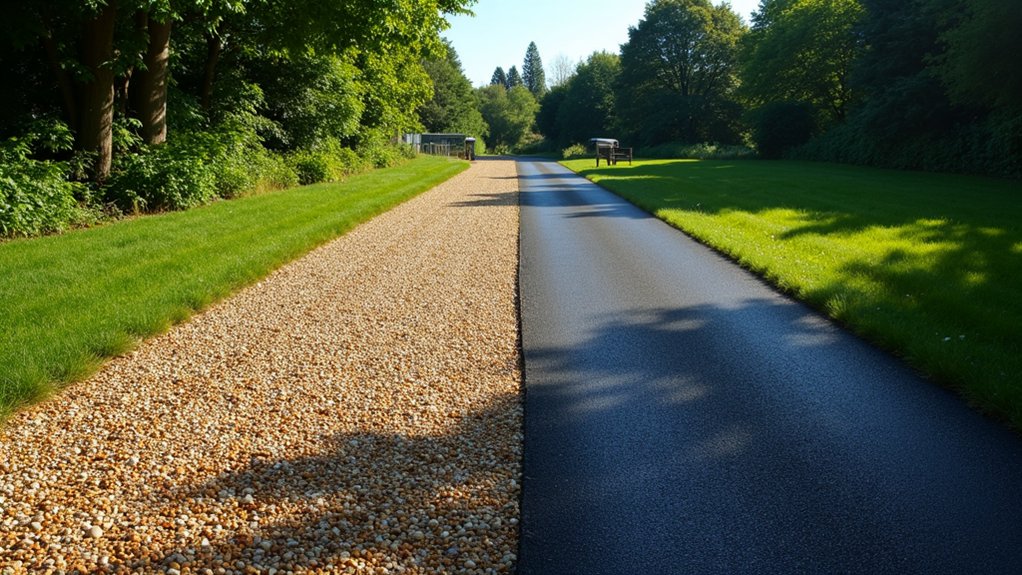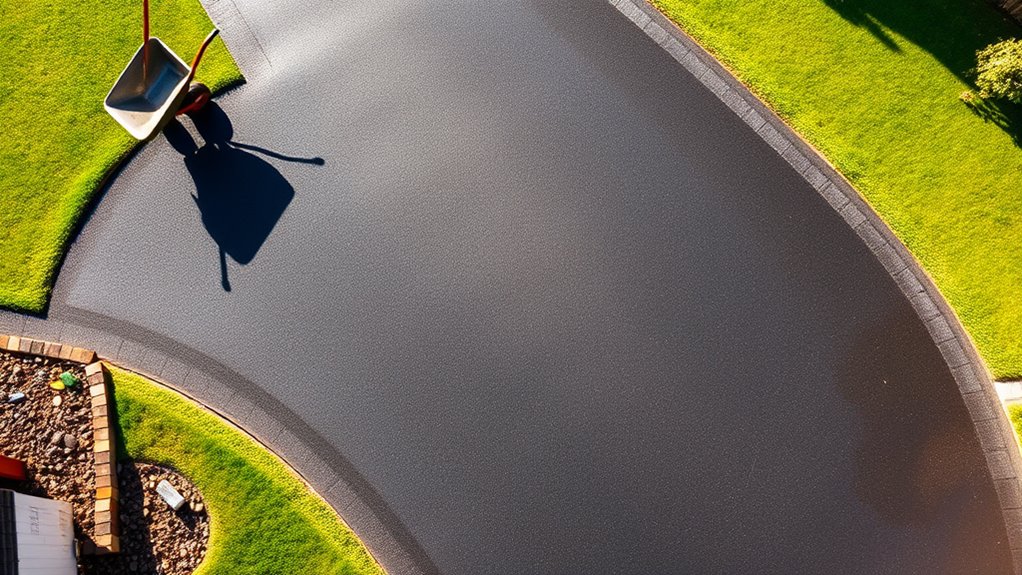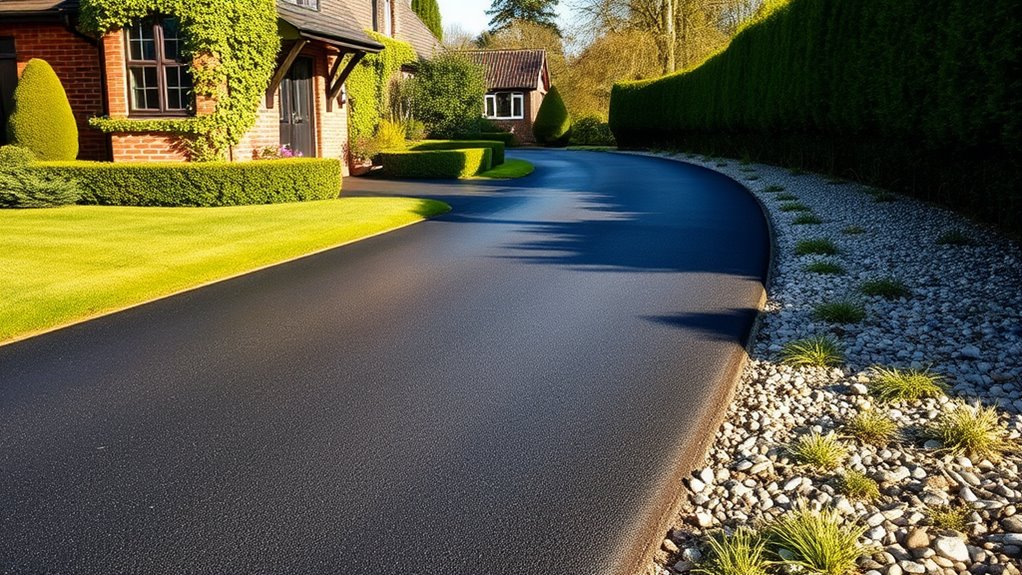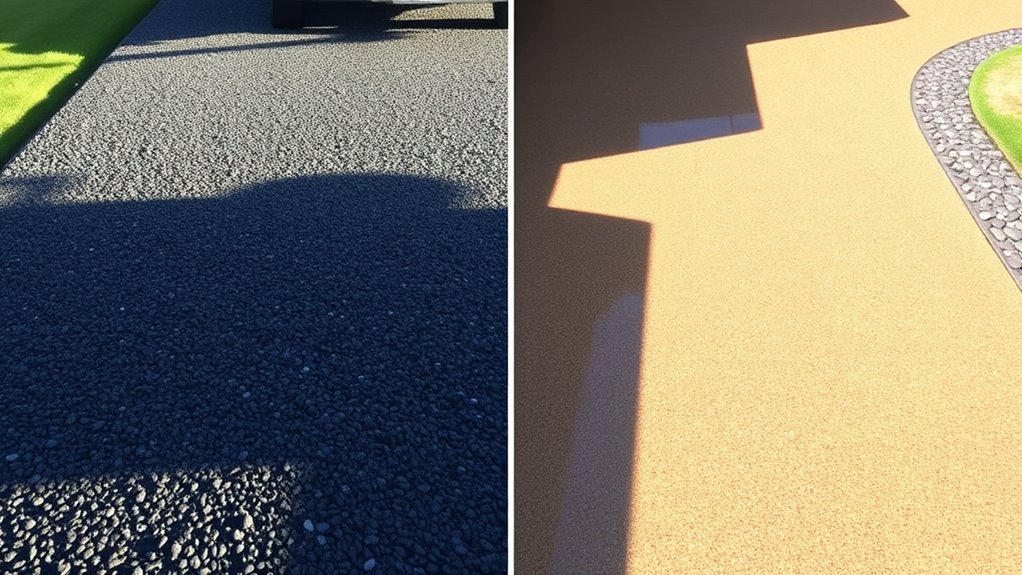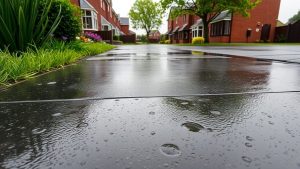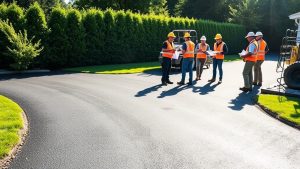When deciding between a gravel driveway and tarmac, think about your budget, traffic levels, and overall appearance. Gravel tends to be cheaper upfront and allows for creative designs, but it does require more upkeep. On the other hand, tarmac boasts durability and a smart finish, making it suitable for heavier vehicles, though it comes with a higher price tag and is less eco-friendly. Both options have their longevity to consider, so take the time to weigh their pros and cons carefully. Determine which choice aligns best with your needs by comparing their features.
Table of Contents
ToggleKey Takeaways
- Gravel driveways are more budget-friendly, with installation costs around £1,200, compared to tarmac, which ranges from £1,800 to £8,000.
- Gravel provides a rustic charm and allows for various design options, while tarmac offers a smooth, modern look but with limited colour choices.
- Gravel demands regular maintenance and occasional replenishment, while tarmac requires resealing every 2-3 years to maintain its durability.
- Gravel is permeable, helping to reduce runoff and support groundwater recharge, whereas tarmac is impermeable, leading to increased surface runoff and greater drainage requirements.
- Tarmac is better suited for heavy loads and extreme weather conditions, while gravel is ideal for light to moderate traffic and excels in drainage.
Cost Comparison of Gravel and Tarmac Driveways
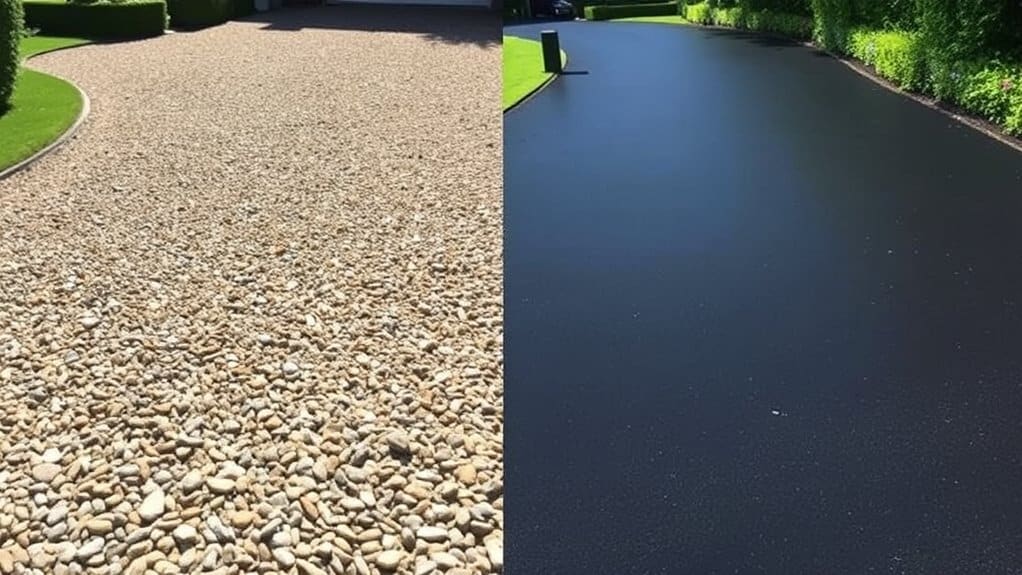
When considering a new driveway, the cost difference between gravel and tarmac (asphalt) can be quite pronounced.
A gravel driveway typically costs around £1,200, with prices ranging from £500 to £1,500, whereas tarmac installations can vary from £1,800 to £8,000. Additionally, tarmac driveways can boost property values by 5% to 10%, making them a worthwhile investment for homeowners.
To break it down, gravel costs between £10 and £20 per square metre, while tarmac ranges from £50 to £100 per square metre. Additionally, gravel is easier to install and often suitable for DIY projects, while tarmac requires professional installation and specialised equipment.
Factors such as the size of the driveway, land preparation, and local labour costs will also affect the overall price. Understanding these costs can help you make a more informed decision, especially considering that gravel driveways can last up to 100 years with proper maintenance.
Durability and Maintenance of Driveway Options
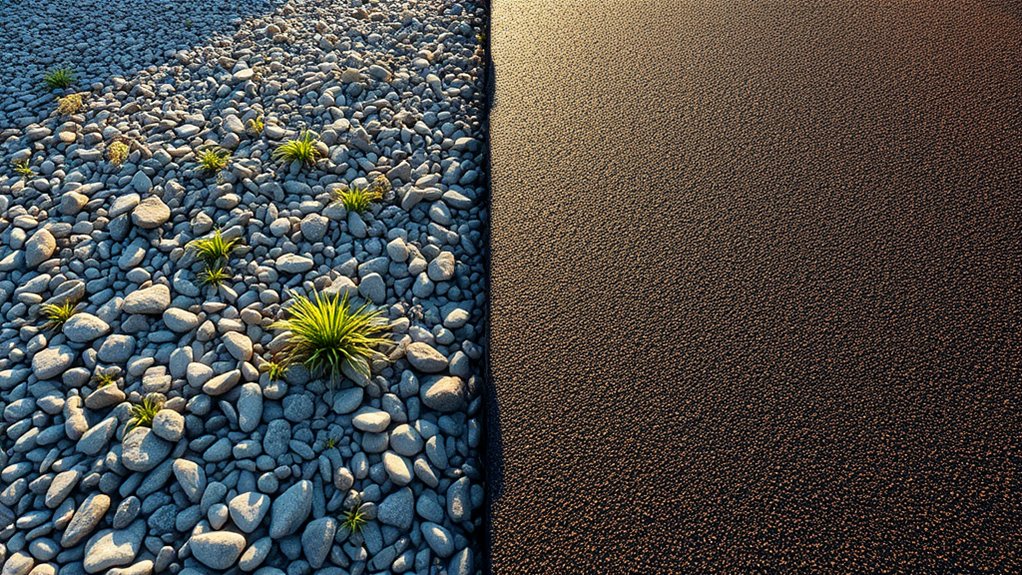
When considering driveway options, gravel and tarmac each have their pros and cons, particularly regarding durability and maintenance. Gravel driveways can last up to 100 years, but they are susceptible to erosion, meaning you’ll need to replenish the gravel and carry out repairs regularly. Additionally, proper base preparation is essential for maintaining the longevity of any driveway material. On the other hand, tarmac driveways generally last between 20 and 30 years, require less upkeep, and are more resistant to the effects of weather. Notably, gravel driveways have lower initial installation costs compared to their tarmac counterparts, making them an attractive option for budget-conscious homeowners.
| Feature | Gravel Driveways | Tarmac Driveways |
|---|---|---|
| Lifespan | Up to 100 years | 20-30 years |
| Maintenance Frequency | Regular gravel replenishment | Sealing every 2-3 years |
| Erosion Resistance | Prone to erosion | Excellent resistance |
Ultimately, the choice between gravel and tarmac depends on your long-term needs and how much maintenance you’re willing to commit to.
Aesthetic and Visual Appeal of Gravel vs. Tarmac
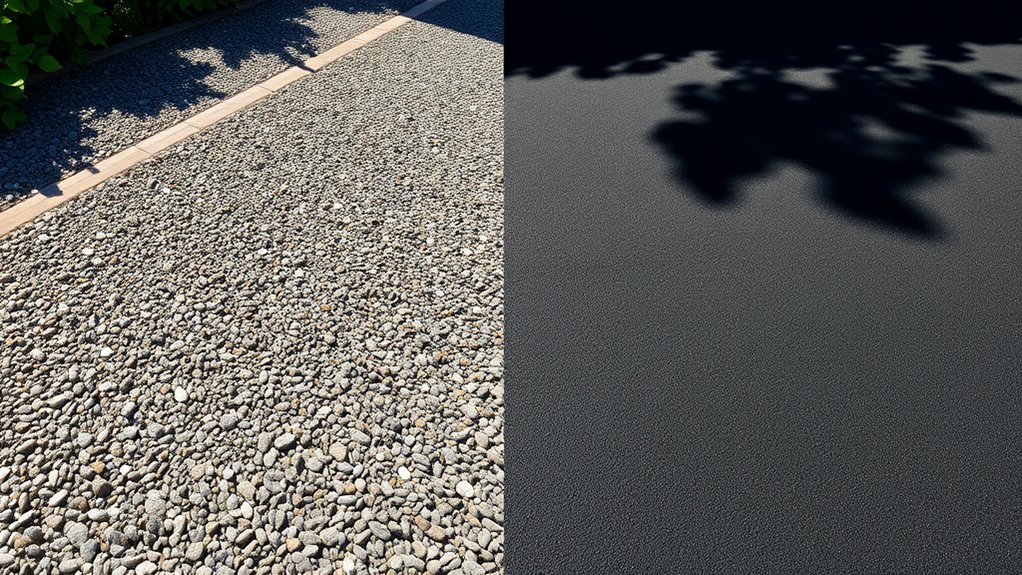
When it comes to the aesthetic appeal of your driveway, gravel provides a rustic charm that suits traditional homes, while tarmac offers a sleek, modern finish. Curb appeal plays a vital role in the impressions made on potential buyers and visitors, making the choice of materials even more significant. You can also create visual interest by mixing materials, such as adding decorative stones or borders to gravel for a unique look. Additionally, tarmac has a limited color choices aspect that might affect its visual appeal compared to more customizable options like gravel. Ultimately, your choice should reflect the style you want and how well it complements your home’s architecture and garden.
Rustic Charm of Gravel
Gravel driveways offer a rustic charm that tarmac simply can’t replicate, making them an attractive option for homeowners who value both practicality and aesthetics. The warm, earthy tones of gravel enhance your landscape and create a soothing atmosphere. With various textures available, gravel adds depth and visual interest to your driveway, complementing different architectural styles.
| Feature | Gravel |
|---|---|
| Colour Options | Wide range of colours |
| Texture Variety | Various textures available |
| Seasonal Appeal | Attractive all year round |
| Environmental Fit | Blends seamlessly with nature |
Opting for gravel allows you to create a unique, personalised design that boosts your home’s appeal while being eco-friendly.
Modern Look of Tarmac
How does the modern look of tarmac enhance the appearance of your property? Tarmac provides a sleek finish with clean lines and a uniform surface that complements any architectural style.
Its versatility allows for a range of textures and colours, from classic blacks to bold reds, enabling you to make thoughtful design choices. You can even add geometric patterns for extra flair.
Tarmac’s sharp appearance contrasts nicely with your landscaping, significantly boosting curb appeal. Innovative features like LED lighting can enhance its visual impact at night, making your driveway truly stand out.
Blending Materials for Aesthetics
The contemporary appeal of tarmac can be enhanced by skillfully blending materials for a distinctive look. Combining tarmac with gravel offers both durability and a touch of rustic charm, resulting in striking contrasts and textures. This flexibility allows you to design a driveway that complements your property’s architectural style.
| Material Combination | Visual Effect | Best Use |
|---|---|---|
| Tarmac & Gravel | Sleek with rustic edges | Residential driveways |
| Gravel Accents | Natural, textured appearance | Countryside homes |
| Colour Variations | Bright and welcoming | Landscaped areas |
With these combinations, you can create an inviting entrance that not only looks good but also serves its purpose effectively.
Environmental Impact and Drainage Capabilities
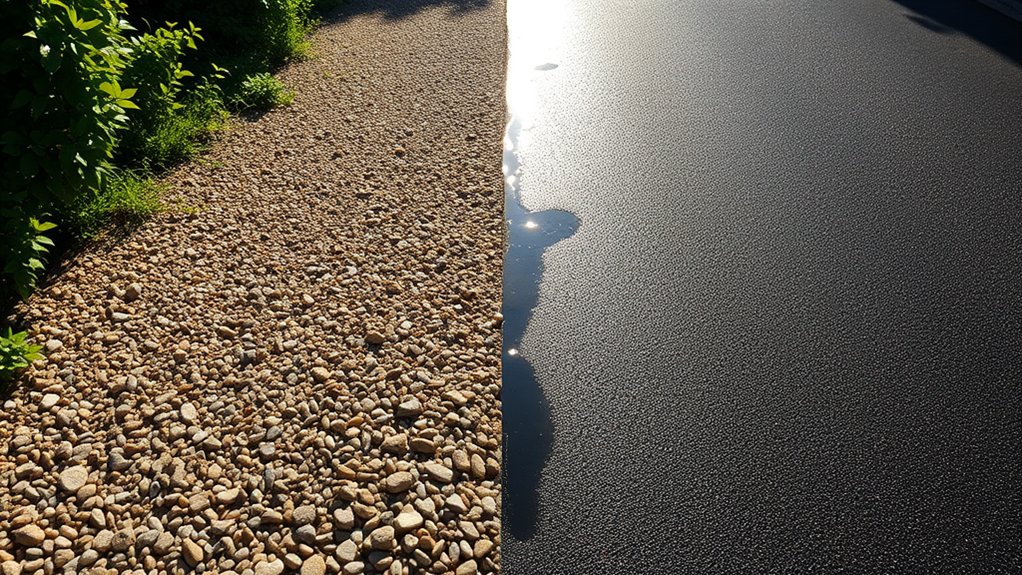
When comparing the environmental impact and drainage capabilities of gravel and tarmac driveways, there are notable differences.
Gravel is permeable, allowing rainwater to seep into the ground, which helps recharge groundwater and reduces surface runoff. For example, after a heavy rain, gravel driveways absorb water, preventing puddles.
On the other hand, tarmac is impermeable, leading to increased runoff. This means that rainwater flows off the surface rather than soaking in, which can overwhelm drainage systems and affect local ecosystems.
Tarmac driveways often require engineered drainage solutions, which can be costly and need regular upkeep.
Permeability and Water Drainage
When choosing a driveway, it’s important to consider permeability and water drainage, as these factors impact both the environment and functionality.
Gravel driveways are particularly effective at allowing rainwater to soak into the ground, helping to replenish groundwater and reduce the risk of local flooding. This natural drainage system helps minimise surface runoff, which in turn lessens the burden on stormwater systems.
In contrast, tarmac driveways are impermeable, leading to water running off the surface and potentially increasing the risk of flooding. Additionally, runoff from tarmac tends to carry more pollutants, raising concerns about surface water pollution.
Opting for gravel not only improves water drainage but also supports soil health and reduces erosion.
With proper care, gravel driveways can provide excellent drainage performance, making them a sensible choice for environmentally aware homeowners.
Carbon Footprint Impact
When choosing a driveway, consider its environmental impact as well as its appearance. Tarmac production is energy-intensive and heavily reliant on fossil fuels, leading to a larger carbon footprint compared to gravel.
Although techniques like warm-mix asphalt can reduce some of this impact, they don’t completely eliminate it.
On the other hand, gravel is a natural material that requires minimal processing, making it a more eco-friendly option. Its permeability allows for groundwater recharge and helps reduce stormwater runoff, which is important for sustainability.
Plus, gravel is easier to install and can be sourced locally, keeping its carbon footprint low over time. By opting for gravel, you not only achieve a stylish driveway but also make a positive choice for the environment.
Weather Resilience Comparison
Understanding the weather resilience of your driveway material is crucial, especially in light of the UK’s varied climate.
Tarmac is known for its durability, effectively handling heavy loads and extreme weather, but it does require good drainage to prevent cracking.
On the other hand, gravel offers excellent drainage, allowing water to flow through and reducing the risk of standing water and erosion during freeze-thaw cycles.
While gravel remains cool in hot weather, it can become uneven and may need maintenance in harsher conditions.
Tarmac, however, provides better traction in snow and ice, making winter maintenance simpler.
Ultimately, your choice should align with your local climate and how much upkeep you’re willing to invest for optimal performance.
Suitability Based on Usage and Climate Conditions
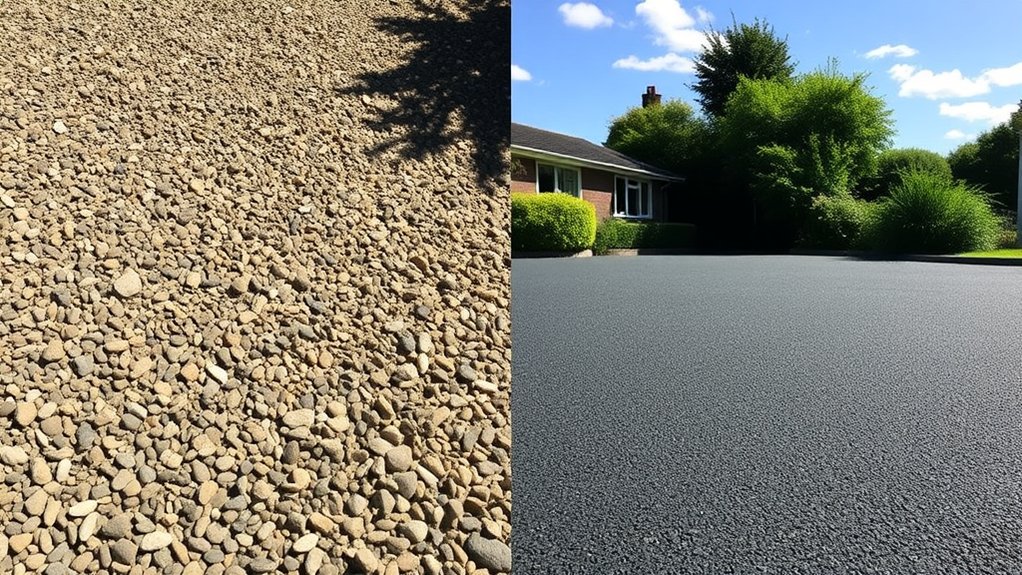
When choosing between gravel driveways and tarmac, it’s essential to consider how often you’ll use the driveway and the local climate.
For light to moderate traffic, gravel is a budget-friendly option, though it does require regular maintenance to keep it looking tidy. On the other hand, if you have heavy vehicles or expect high traffic, tarmac is more durable and can withstand wear and tear better.
Climate also plays a crucial role. Gravel is great for areas with heavy rainfall as it drains well, but clearing snow from a gravel driveway can be challenging.
Tarmac, however, holds up well in cold weather and needs less maintenance overall.
In short, align your choice of driveway material with your expected usage and the climate in your area to ensure it meets your needs effectively.
Noise Levels and Additional Considerations
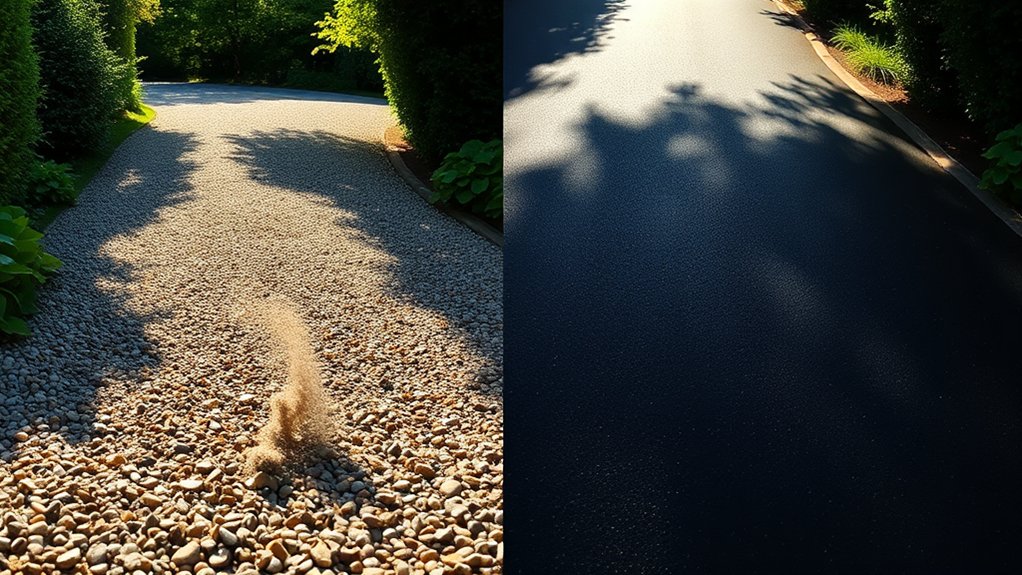
How much noise from your driveway can you handle? If you prefer peace and quiet, tarmac is your best option.
Its smooth surface reduces noise significantly compared to gravel, which can create annoying crunching sounds from loose stones, especially with heavier traffic or rain. In a quiet neighbourhood, this noise can be quite disruptive.
While using smaller stones or a sand layer might help a bit, these solutions only offer minimal relief. Tarmac is also durable and low-maintenance, further reducing noise from any surface cracks.
Choose wisely; the sound of your driveway can impact your living environment.
Longevity and Repair Options for Driveways
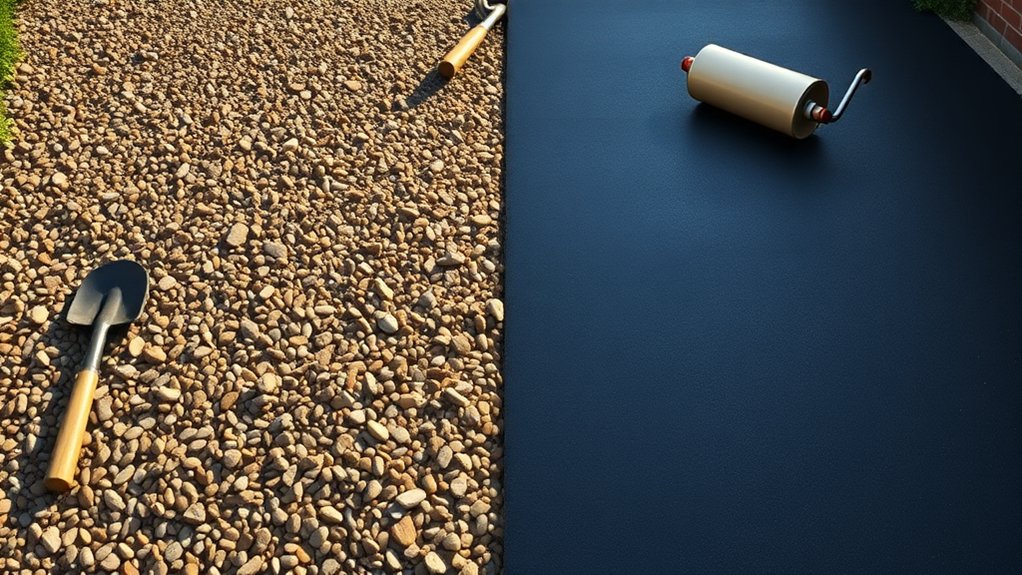
When choosing between gravel and tarmac driveways, it’s essential to understand their differences in longevity and repair needs, as these factors will affect your long-term maintenance plans.
1. Gravel Driveway Lifespan: With proper upkeep, gravel can last for decades, but it often requires topping up every 1 to 3 years due to erosion and shifting.
For instance, if you live in an area with heavy rainfall, you might find yourself replenishing the gravel more frequently.
2. Tarmac Driveway Lifespan: Tarmac generally lasts between 15 to 20 years.
To keep it in good shape, you’ll need to reseal it periodically and address cracks as they appear. If you notice a few cracks forming, it’s best to repair them sooner rather than later to prevent more extensive damage.
3. Repair Frequency: Gravel repairs are typically more frequent but less costly.
In contrast, while tarmac repairs are less common, they can be more expensive and complicated. For example, fixing a large crack in tarmac might require professional help, whereas maintaining gravel can often be a DIY job.
Ultimately, think about your local environment and how you use your driveway to decide which option suits your needs best in terms of longevity and repair.
Frequently Asked Questions
How Do Gravel and Tarmac Driveways Affect Property Value?
Gravel and tarmac driveways can significantly affect property appeal. Tarmac is often seen as a more durable option with lower maintenance costs, making it attractive to buyers. In contrast, gravel driveways require more upkeep, like regular raking and weed control.
For instance, a well-maintained tarmac driveway can enhance a property’s value, while a neglected gravel drive can deter potential buyers. Ultimately, your choice can impact both immediate selling price and long-term investment returns.
Can I Install Gravel or Tarmac Myself?
Can you handle a DIY installation? While gravel is simpler and more cost-effective, laying tarmac is more complex and usually requires a professional. Think about your skills and budget when comparing these two options. For instance, if you’re good with tools and want to save money, gravel might be the way to go. However, if you’re looking for durability and a polished finish, it’s best to hire an expert for tarmac.
What Is the Best Base Material for a Driveway?
For your driveway, consider base materials such as crushed stone or type 1 aggregate. Proper installation is key to ensuring stability and good drainage. Make a wise choice to boost durability and reduce future maintenance, ensuring lasting performance.
How Do Weather Conditions Affect Installation Timing?
Weather significantly affects installation schedules. It’s best to aim for dry, mild conditions to ensure proper compaction and avoid delays. For instance, installing during wet weather can lead to surface defects and future maintenance problems. Prioritising good weather can save time and money in the long run.
Are There Any Local Regulations for Driveway Materials?
Imagine your driveway shining in the sunlight. Before you begin, however, be aware that local regulations may limit the materials you can use. Ensure your plans comply with these rules to avoid expensive changes or fines during construction. For instance, some areas might prohibit impermeable surfaces to prevent flooding. Always check with your local council before starting your project.
Conclusion
When choosing between gravel and tarmac driveways, the decision can be tricky. Gravel is often more affordable and adds a rustic appeal, while tarmac is known for its durability and sleek appearance. Before making a choice, consider your local climate and how you’ll use the driveway.
For instance, gravel can become muddy in wet weather, while tarmac provides a sturdy surface that’s easy to maintain. If you’re looking for a blend of aesthetics and functionality, think about combining both materials. Ultimately, your choice will impact your property’s value and curb appeal. Which option suits your needs best? The decision is in your hands.
How can a tarmac driveway enhance your home's appeal? Discover the key aspects of cost, installation, and maintenance in our Read more
Wondering if a tarmac driveway is the perfect fit for your home? Uncover the essential pros and cons before making Read more
Choosing between a tarmac and resin driveway can be challenging; discover the key factors that could influence your decision.

